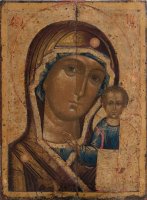 The Day of the Kazan Icon of the Mother of God, celebrated on November 4th, is one of the main Orthodox holidays in Russia. This day commemorates one of the most significant events in Russian history: the liberation of Moscow and all of Russia from Polish invaders in 1612. It symbolizes not only deep religious devotion but also the unity of the people.
The Day of the Kazan Icon of the Mother of God, celebrated on November 4th, is one of the main Orthodox holidays in Russia. This day commemorates one of the most significant events in Russian history: the liberation of Moscow and all of Russia from Polish invaders in 1612. It symbolizes not only deep religious devotion but also the unity of the people.
History of the Kazan Icon of the Mother of God
The Kazan Icon of the Mother of God was discovered in 1579 in the city of Kazan after a devastating fire that destroyed part of the city. According to legend, the Virgin Mary appeared to a young girl, Matrona, pointing out the location of the hidden icon. The newly found icon quickly gained fame for its miracles and became recognized as a protector of the Russian people. Just a few decades later, in 1612, Minin and Pozharsky carried this icon in their struggle to inspire the people to free Russia from foreign occupation.
Significance of the Holiday
This holiday encompasses both religious reverence for the Mother of God and national unity and devotion. The Kazan Icon became a symbol of protection and support for all Orthodox believers. The day of the Kazan Icon reminds people that faith can bring strength and resilience during times of trial.
Traditions of Celebration
On this day, Orthodox churches hold special prayer services and processions, and many people attend with family members to pray for health and unity. The holiday is also celebrated as a time of family and communal gatherings, with prayers for peace and understanding.
Cultural Influence of the Kazan Icon
The Kazan Icon of the Mother of God is depicted in art, literature, and folk culture, symbolizing strength of faith and hope for protection and support. The significance of this day goes beyond religion to remind Russians of the importance of unity, mutual help, and genuine belief. In 2005, Russia established November 4th as National Unity Day, recognizing the historical and spiritual significance of this day.


